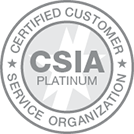Using Your Website to Attract, Engage and Retain Members
The Innovation Series —inspired by Leadership Forum, AH’s exclusive client-only event—seeks to uncover the biggest, best “what’s next” ideas for associations.

Although a website may be considered the “front door” to an organization, many are missing out on its innovative potential to boost an association’s membership and its overall success.
With the right build, what appears to be an unassuming website on the surface can be transformed into a vital, innovative tool for members to connect and network, attend events, and raise the online profile of the association – increasing both the value of membership, membership engagement, and membership numbers themselves.
A Next-Level User Experience
The first and most important step for an association to take when deciding upon a website build or redesign is to determine what is most important to its members, and to back that up with actual data.
When the International Energy Credit Association (IECA) sat down to discuss the rebuild of their site with Craig Broadbent, Director Web Solutions and Client Engagement at AH, he discovered that one of the most important issues for their members was peer-to-peer networking – especially in the context of its member directory and their numerous conferences and events.
“We took that feedback and distilled it into three key points the website would need to deliver on: networking, ease of finding people, and getting information about events and resources,” said Broadbent.
The IECA already had a large member directory that allowed the user to search using 10 different fields to narrow people down. At first, the IECA saw those fields as an essential search component to keep. However, Broadbent explained, it was important to track the actual usage first.
“It’s important to get the actual data on how things are being used. In this case, the web and digital technology team did that by using Google Analytics, and we found that, in reality, no one uses all of those fields. We were able to eliminate what was not being used and could focus on actual member needs, based on the data we analyzed.”
Once free of the need to have multiple fields to search, the web team could then explore other ideas that went beyond merely going to one page to find one piece of information, and then to another to find another piece.
Because IECA members regularly present at conferences, look each other up in the directory, and utilize a member-developed research library, it was decided that a dashboard capability would be ideal. Once a member logged in, they would be able to click onto a dashboard with tabs such as “My Contacts,” “My Events,” and “My Resources,” where they could place information from their personal searches. This information would then be saved onto the dashboard and be available every time the member logged in, much like a personalized Rolodex. Additionally, profiles of members included photos, a listing of their favorite events, downloaded V-cards, and one-tap email and call features, making it easier to directly contact and network among members.
Though the project took nearly 5 months to complete, the results pointed to success. The IECA saw a 7.96% increase in users, and a 7.73% increase in first-time users.
“The response from members was extremely positive with the intuitive navigation, modern look, increased functionality, and the incorporation of a personal touch with photos of real members,” said Michele Buggy, Executive Director of IECA. “Our visits also went up dramatically year over year.”
Turbo-Charged SEO
However, the most powerful build within a website is not always readily visible.
An association exists to bring both tangible benefits to its members, as well as intangible value as an industry thought leader. When someone searches online for a topic that is important to your industry, your association should be listed among the top search results in order for prospective new members to find your site, and to maintain a reputation as a trusted authority.
“There’s a saying that the best place to hide a dead body is on page two of a Google search result,” said Jon Kinsella, director of digital marketing at AH. “No one looks there. When someone is carving time out of their day to specifically look for the information you have to offer, this is where your most-engaged audience comes from. You want them to find you right then and there.”
And the easiest, most cost-effective way to ensure they do, according to Kinsella, is using an SEO-friendly model based on the concept of topic clusters.
Far from being mysterious or complicated, a successful digital marketing strategy when it comes to your website, is using topic clusters, or topic-focused SEO. It is a simple concept focused on organizing a site’s content to “prove” to a search engine that its site is an authority on the topic being searched – and should therefore rank high in the list of results.
“Google no longer ranks sites for an isolated piece of content,” said Kinsella. “This is an advantage for a website with a lot of quality content related to a specific industry.”
A website that is built on the topic cluster model has a single pillar page that acts as the main hub of content for an overarching topic, with multiple subtopic content pages linking back to the pillar page and to each other. When a search engine “crawls” the website, it sees all the topics linked together and concludes it is an authority on the topic. From there, fresh content can be added throughout the year using hyper-focused clusters that are geared toward those subtopics.
“This allows the association the flexibility to go off on subtopics while still ranking high in search engines, and provides a better user experience for the site overall,” said Kinsella.
The HVAC Inspection, Cleaning and Restoration Association (NADCA) consulted AH about switching its website from keyword to topic-focused SEO, and to prepare it for future updates. Since their main goal was to increase NADCA’s consumer reach, AH designated “A Homeowners Guide to Air Duct Cleaning” as the pillar page, and established a core topic with five subtopic clusters using keyword research. Thus, the internal linking between each page was managed more efficiently, and there was a boost in NADCA’s search ranking.
In fact, when NADCA compared their year-over-year data, it saw a significant increase in organic traffic –an 84% increase in organic traffic to the homeowners section of the website, and a 65% increase in organic traffic to NADCA’s “Find a Professional” webpage. In addition, their keyword rankings improved in several key search phrases, including “air duct cleaning”( ranking #5, up from #11) and “HVAC air duct cleaning” (ranking #4, up from #17). Read more about how search engine optimization improved NADCA's rankings and organic traffic.
Planning Your Site Build
There’s a lot to consider when deciding on your association’s build. Find out more about how AH’s Web and Digital Technology team can build and optimize a website specific to your membership’s needs.




